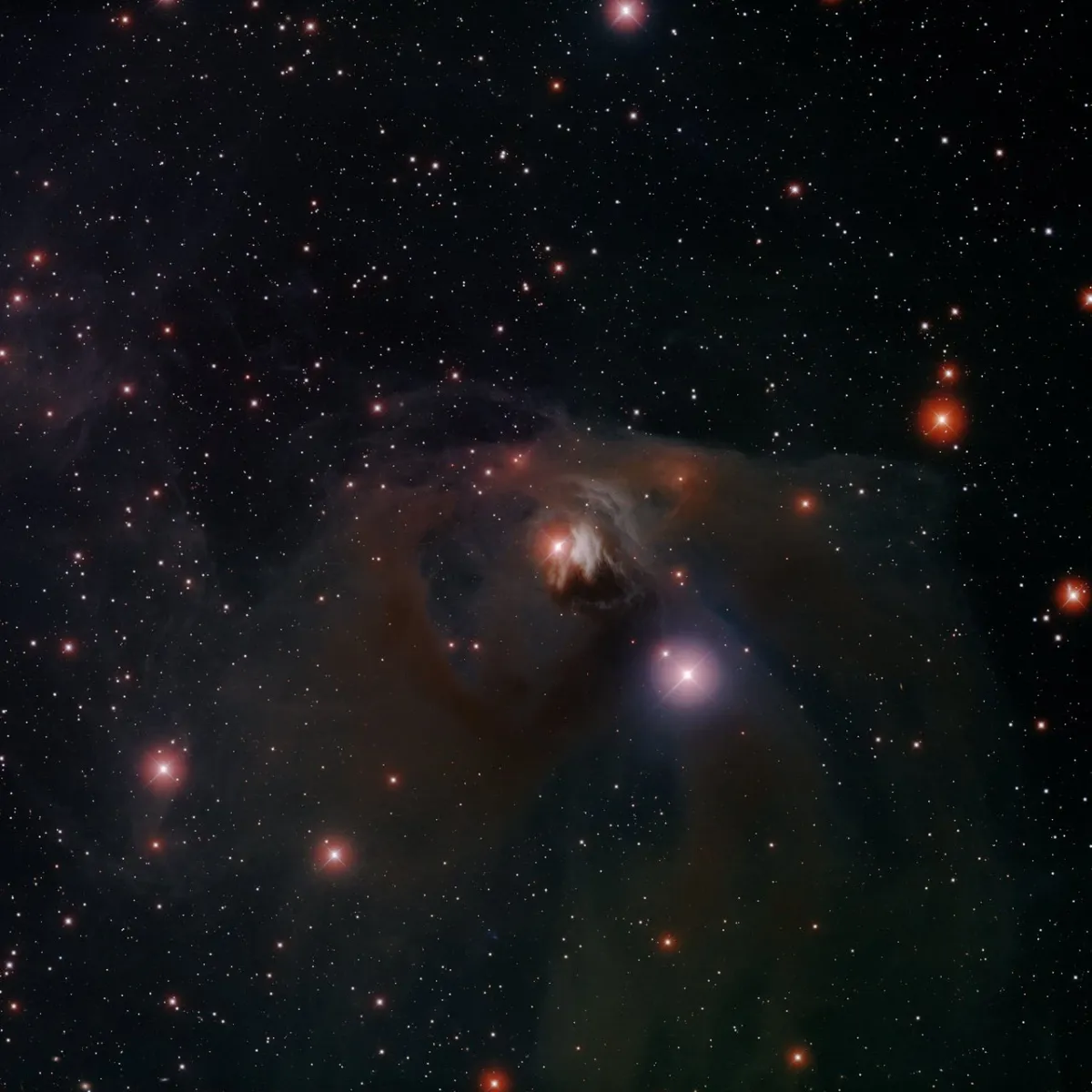Hinds variable Nebula (NGC 1555)

History
The Danish/British astronomer John Louis Emil Dreyer wrote the following note on NGC 1554 (GC 5539) and NGC 1555 (GC 839) in his «New General Catalogue of Nebulae and Clusters of Stars», published in 1888: «The latter is the well-known nebula, found by Hind on 11 October 1852 (Astr. Nachr. 839), observed by d'Arrest in Leipzig four times from 1855-56 as a fairly bright or fairly faint nebula, about one [arc] minute in diameter and d Arrested in October 1861 found missing. GC 5539 is a small nebula with an eccentric core with a star of 14 mag, which was found at the beginning of 1868 by Otto Struve and was also sighted by d'Arrest (Astr. Nachr. 1689), who was certain that there was no nebula beforehand this place existed (4' west of Hinds Nebel). So this object must have disappeared since then, as I could not see any nebula at the spot with Lord Rosses 6 feet reflector in 1877. The site has also been investigated by Tempel in recent years with a similar result. (A.N. 2212). The place for G. C. 839 is the result of the four observations made by d'Arrest in Leipzig.» [313]

In the first edition of the «Index Catalogue», published in 1895, there is a note on NGC 1554, which actually fits NGC 1555: «Hinds variable nebula, 2s west and 40" south of the variable star T Tauri. In 1890 Barnard found a very faint nebula Position 185°, 3/4' of T, which agrees well with the observations of Hind and d'Arrest. Barnard and Burnham also saw T Tauri shrouded in a very small and concentrated nebula (often seen at Temple). Bigourdan's No. 144 (* 13 nebulous?) [...] apparently had not been seen at the Lick Observatory.» [314]
The second edition of the «Index Catalogue», published in 1908, contains a note that fits both nebulae: «NGC 1554-55: Hinds variable nebula. Barnard found (with the 36 inch refractor) in February and March 1895 that T Tauri was not, as stated in 1890, the core of a rather bright, little nebula. The star was perfectly stellar, but shrouded in a rather faint, diffuse, nebulous glow. Struve's nebula was not seen, but there may have been a faint haze there. [...] In September 1895 no trace of Hind's nebula was seen with the 36 inch [refractor] for three nights. [...] On two photos from December 1899, Keeler found three very faint, irregular spots, connected with an even faint nebula south and southwest of T Tauri, but away from the star. No sign of Struve's nebula. [...] Not visible to Burnham around 1907.» [315]
As can be seen from the notes in the NGC and IC catalog, the two NGC numbers have always been associated with each other and with the star T Tauri. These are undoubtedly variations of the different lighting of the dust and gas clouds around the star T Tauri, which cast different shadows on the nebula behind by their own movement of dense dust clouds. Hence the name «Hinds Variable Nebula» for NGC 1555. Since Struve's observed nebula (NGC 1554) has not been sighted since then, it was nicknamed «Struve's Lost Nebula». The entire nebula is also listed in the second Sharpless catalog under the number Sh2-238.
Physical Properties
According to a measurement by the Gaia space probe from 2018, the star T Tauri is at a distance of 144'321 parsecs (around 470 light years). As can be seen in Fig. 1 and Fig. 2, only a small part of the entire nebula is illuminated by the star T Tauri. Most of it is dark. The star T Tauri is the prototype of a whole class of very young stars (T Tauri stars), which only recently freed themselves of gas and dust from their cocoons. [145, 317]
| Name | RA | Dec | Type | Dim | MD | Dreyer Description | Identification, Remarks |
|---|---|---|---|---|---|---|---|
| NGC 1554 | 04 21 43.5 | +19 31 16 | *2 | !!! var, S, R, Nn = * 13 | GC 5339; LBN 817; CED 32A; Struve's Lost nebula | ||
| NGC 1555 | 04 21 56.7 | +19 32 04 | RN | 0.5 | 0.144 | !!! vF, S, variable (Auw 20) | GC 839; DG 31; CED 32B; vdB 28; Hind's variable nebula |
Finder Chart
The star T Tauri with the nebula NGC 1555 is located in the constellation Taurus north of the Hyades. The best observation time is July to May.
Visual Observation
400 mm Aperture: Even at high magnification, nothing of the reflection nebula around T Tauri is visible. — 400 mm f/4.5 Taurus Dobsonian, Hasliberg, 16. 12. 2023, SQM 21.2, Bernd Nies
